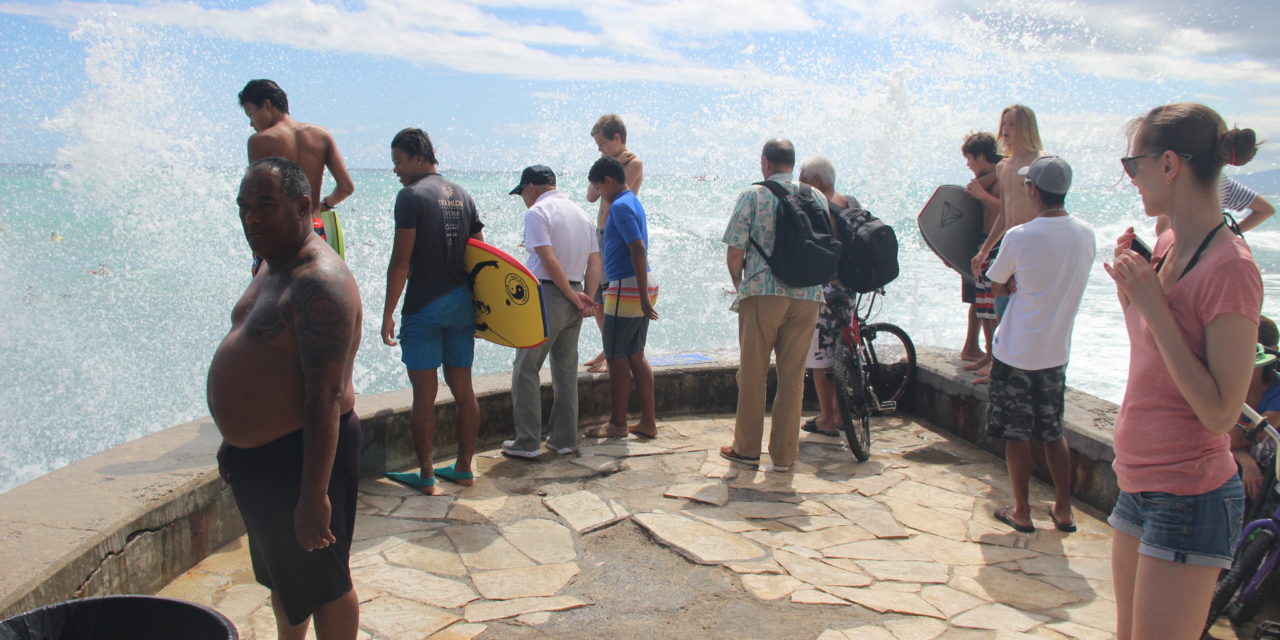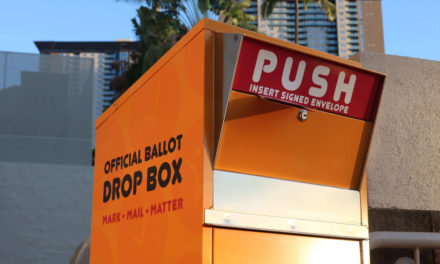By Chris Takahashi | Staff Writer
The “king tides” that affected the shores of the Hawaiian Islands last week, beginning May 25 and lasting through the weekend, gave both locals and visitors a taste of what we can expect in years to come if we do little to mitigate the impacts of climate change.
The king tides themselves are a naturally occurring and seasonally predictable event (having to do with the gravitational pull of the moon and not increasing carbon dioxide levels that warm the climate), but coupled with the high surf and already elevated sea levels, this convergence of events gave way to a surreal scene down at the beach. This scene was a visible prelude of the very real and acute effects brought forth by a warming climate. Just how those effects might specifically impact Hawai‘i hardly looks promising.
For citizen-updated photos of the king tide event in Waikīkī and beyond, check out this website from the University of Hawai‘i Sea Grant Program documenting the ongoing phenomenon. King tides are also predicted for this summer in June and July.
The estimates for the amount of sea level rise we can expect by the end of this century vary in scope, but the mean estimates pinpoint to a number right around three feet. If you take a look at what three feet of sea level rise means for a neighborhood like Waikīkī, you might be pleasantly surprised, but you may not be entirely shocked. Low-lying Waikīkī, which had all the characteristics of a swamp before modern development, will actually start to resemble much of its former swampy landscape after just a three-foot rise in sea levels.
The diagram that depicts the impacts we could expect from three feet of sea level rise in Honolulu, produced by the UH Mānoa Coastal Geology Group, shows the Ala Wai canal swelling and spilling over in both directions. New tributary canals and streams, in addition to localized flooding events from future combinations of king tides and high surf, will make entire swaths of the Waikīkī and Mō‘ili‘ili neighborhoods practically uninhabitable.
The upper limit to sea level rise is theoretically a much higher number, especially since scientists have already begun to warn us about the risk of “runaway” climate change. For example, melting permafrost in the Arctic may release tremendous quantities of frozen methane, which is actually a much more potent greenhouse gas in terms of warming potential than carbon dioxide. More warming leads to more methane being released; a positive feedback loop takes hold that would be nearly impossible to reverse without feats of geoengineering … but that’s hardly an optimal solution.
The slow but steady rise of sea levels is ultimately a disastrous threat to Honolulu and the entire state. As such, it demands serious attention.
The Pacific Islands Ocean Observing System (PacIOOS) at UH Mānoa has partnered with the National Oceanic and Atmospheric Administration (NOAA) for a report published in 2014 on the impacts of predicted sea level rise in Hawaiʻi. The impacts specific to Honolulu are especially dire: they report that almost half of the area’s population and approximately 80% of the region’s economy come under direct threat from rising sea levels.
That would mean that the story of urban Honolulu, at least post World War II, will be an incredibly short-lived chapter in the books of history if sea levels inundate the city by the end of this century.
While that’s not the most comforting thought, I don’t personally believe we should throw our hands up in despair. There’s good reason to be optimistic about our approach in tackling the multifaceted challenges posed by climate change.
For starters, we have a very sound understanding that we are warming our atmosphere through the burning of fossil fuels such as coal, oil, and natural gas. This much we understand to be an unequivocal fact.
Though the Trump administration’s callous regard toward scientific facts, including the bogus debate on the reality of man-made climate change is both alarming and embarrassing, we should remain diligent in the technological-based facet of our approach to climate change.
This means that Hawai‘i should continue to pave the way nationwide in terms of developing clean energy resources that curtail our carbon footprint. Already on the books is legislation that will have the state powered entirely by clean energy by 2045. Some folks estimate that Hawaiian Electric Co. (HECO) might hit this figure even earlier than the proposed deadline.
Unfortunately, even as Hawai‘i leads in this area, the rest of the mainland may be sluggish to follow the pace. Sea level rise hits Hawai‘i particularly hard, so the stakes here are higher and the consequences likely more acute than elsewhere.
Furthermore, the linkage between our dependence on dwindling global oil and coal supplies in the face of rising sea levels gives pause to more critical thought and debate. How do we transform Hawaiʻi’s economy into one that is both prosperous and sustainable?
That type of question will certainly be at the forefront of discussion for policymakers moving forward. The problems from our energy choices already impact Hawaiʻi at the current moment in time, and sometimes in sneaky ways.
At a localized scale, seafood consumption in Honolulu is the highest per capita nationwide, according to the U.S. Bureau of Labor Statistics. That by itself is no means a groundbreaking revelation.
However, what is important to note, is that our direct reliance on burning coal has a profound and direct impact on the seafood we consume here in Hawaiʻi. Coal-fired power plants, in addition to releasing carbon dioxide into the atmosphere, also emit mercury, which is a known neurotoxin.
This mercury enters the marine food chain, and through bioaccumulation, concentrates in higher quantities in seafood such as tuna. There’s good reason that health officials warn the public to limit exposure to this type of fish commonly prepared as poke or sashimi in Japanese restaurants. It all begins with our energy policy that fails to take into account the environmental and public health externalities of burning coal.
The story in our collective fight against climate change and rising sea levels will leave a lasting legacy here in Hawai‘i no matter the outcome. It was at the Mauna Loa Observatory, on the Big Island, where Charles Keeling and colleagues first began to collect consistent data on atmospheric carbon dioxide levels back in 1958. The first recordings showed atmospheric levels to be at 313 parts per million (ppm). We’ve since exceeded 400 ppm.
So, it will be here in Hawai‘i that we face serious consequences from sea level rise if we fail to adequately respond to those ever-increasing carbon dioxide levels. There’s still hope for a positive outcome, to at least maintain a lower than predicted rise in sea levels, and though it won’t be an easy path to follow, keeping Honolulu above water will certainly be a worthwhile task.






